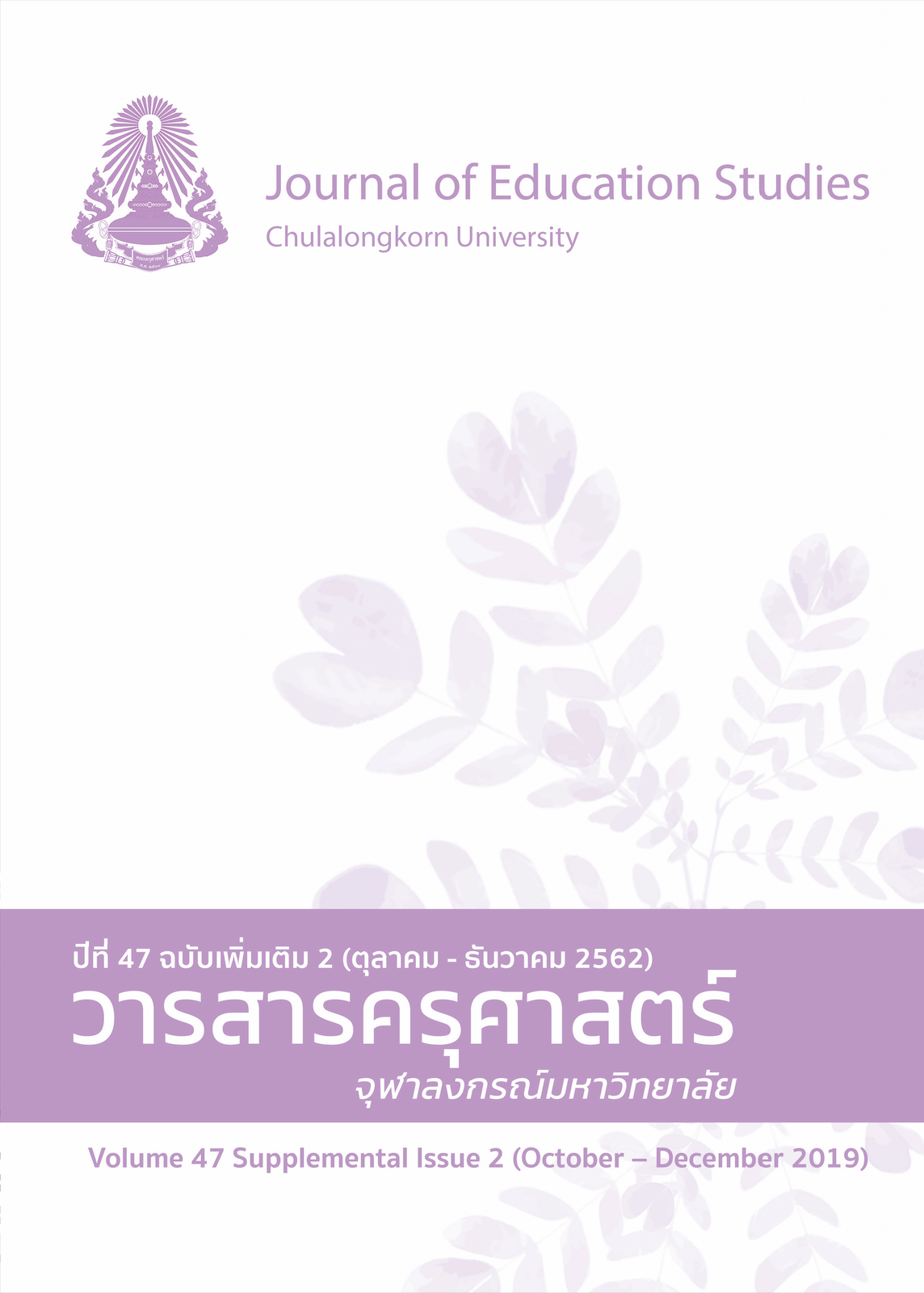Development of Exercise Program Using Sensory Integration Theory with Thai Wisdom to Improve Health–Related Physical Fitness and Social Skills of Autistic Children
Keywords:
AUTISTIC, / HEALTH-RELATED PHYSICAL FITNESS, SOCIAL SKILL, THAI WISDOM, SENSORY INTEGRATION THEORYAbstract
The purposes of this research were 1) to develop an exercise program using sensory integration theory with Thai wisdom to improve health-related physical fitness and social skills of autistic children, and 2) to evaluate the effectiveness of an exercise program using sensory integration theory with Thai wisdom to improve health-related physical fitness and social skills of autistic children. The subjects of this study were 8 children of 12–18 years old who were diagnosed with autism at a moderate level. Those autistic children were purposively selected. The subjects were trained in 45 minute sessions, 3 times a week for 8 weeks. Data were collected before the experiment, immediately after the experiment and again after 2 weeks, and were analyzed by descriptive statistic, one-way ANOVA with repeated measures and t-test. The research results findings were as follows:
1) The develop program consisted of 3 intervention activities: Thai traditional play using a loincloth, individual exercise, dual exercise, and group exercise. There were 26 exercise posts and 5 steps in the exercise. The program had an aggregate IOC of 0.94.
2) The health-related physical fitness of autistic children after the experiment and in the following 2 weeks was higher than before the experiment at a 0.5 level of significance.
3) Skills in social interaction, social communication and working with others compared to after the experiment was higher than before the experiment at a 0.5 level of significance.
References
กรมสุขภาพจิต กระทรวงสาธารณสุข. (2541). คู่มือส่งเสริมสุขภาพจิตนักเรียนระดับมัธยมศึกษาสำหรับครู. สืบค้นจาก https://www.dmh.go.th
กระทรวงการท่องเที่ยวและกีฬา. (2555). สมรรถภาพทางกาย. สืบค้นจาก www.dpe.go.th
ทวีศักดิ์ สิริรัตน์เรขา. (2555). ออทิสติก. สืบค้นจาก www.happyhomeclinic.com/
นิรุตติ์ สุขดี. (2557). ผลของการออกกำลังกายโดยใช้โบซูบอลที่มีต่อการทรงตัว ความแข็งแรงของกล้ามเนื้อและระบบไหลเวียนโลหิตของเด็กออทิสติก. (วิยานิพนธ์ปริญญามหาบัณฑิต,
จุฬาลงกรณ์มหาวิทยาลัย).
เพ็ญแข ลิ่มศิลา. (2545). เด็กออทิสติกคือใคร. กรุงเทพฯ: สำนักพิมพ์แห่งจุฬาลงกรณ์มหาวิทยาลัย.
พระราชบัญญัติ การศึกษาแห่งชาติ พ.ศ. 2542 แก้ไขเพิ่มเติม (ฉบับที่ 2) พ.ศ. 2545 และ (ฉบับที่ 3) พ.ศ. 2553. (2542, 19 สิงหาคม). ราชกิจจานุเบกษา. เล่ม 116 ตอนที่ 74 ก. หน้า 1.
พรศิริ บรรจงประเสริฐ. (2552). การส่งเสริมและพัฒนาทักษะทางสังคมของเด็กออทิสติกด้วยกระบวนการวิจัยปฏิบัติการแบบมีส่วนร่วม ในโรงเรียนที่จัดการเรียนร่วม: พหุกรณีศึกษา
(วิทยานิพนธ์ครุศาสตรมหาบัณฑิต, จุฬาลงกรณ์มหาวิทยาลัย).
สุรัติ จิระพงษ์. (2553). ผลของการออกกำลังกายโดยใช้กิจกรรมการเคลื่อนไหวเบื้องต้นที่มีผลต่อความสามารถในการทรงตัวของเด็กออทิสติก. (วิยานิพนธ์ปริญญามหาบัณฑิต, จุฬาลงกรณ์มหาวิทยาลัย).
สำนักงานหลักประกันสุขภาพแห่งชาติ. ผลการสำรวจผู้ป่วยโรคออทิสติกในประเทศไทย. สืบค้นจาก www.nhso.go.th/frontend
สุพัตรา รัชอินทร์. (2014). การบูรณาการประสาทรับความรู้สึกผ่านกิจกรรมการเล่นในเด็กออทิสติกระดับปฐมวัย. The Journal of Community Mental Health,1, (1), 62-66.
อุลัยวรรณ์ โกสาเสนา. (2555). ผลของการเล่นบำบัดแบบครอบครัวมีส่วนร่วมต่อพัฒนาการด้านสังคม สติปัญญา และภาษาของเด็กออทิสติก (วิทยานิพนธ์พยาบาลศาสตรมหาบัณฑิต, จุฬาลงกรณ์มหาวิทยาลัย).
เอมอัชฌา วัฒนบุรานนท์. (2559). การวิจัยพัฒนาโมเดลเลิฟเพื่อสร้างเสริมความเป็นมนุษย์ที่สมบูรณ์: ชุดโครงการวิจัยสำหรับนิสิตระดับอุดมศึกษา. กรุงเทพมหานคร: โอ เอส พริ้นติ้งเฮาส์.
ภาษาอังกฤษ
Kamp-Becker I., Schroder J., Remschmidt H., & Bechmann C. J. (2010). Health-related quality of life in adolescents and young adults with high functioning autism-spectrum disorder. Psychosoc Med, Doc03.
Karim, A. E. A., & Mohammed, A. H. (2015). Effectiveness of sensory integration program in motor skills in children with autism. Egyptian Journal of Medical Human Genetics, 16(4), 375-380.
Tyler, K., MacDonald, M., & Menear, K. (2014). Physical activity and physical fitness of school-aged children and youth with autism spectrum disorders. Autism research and treatment, 2014.




